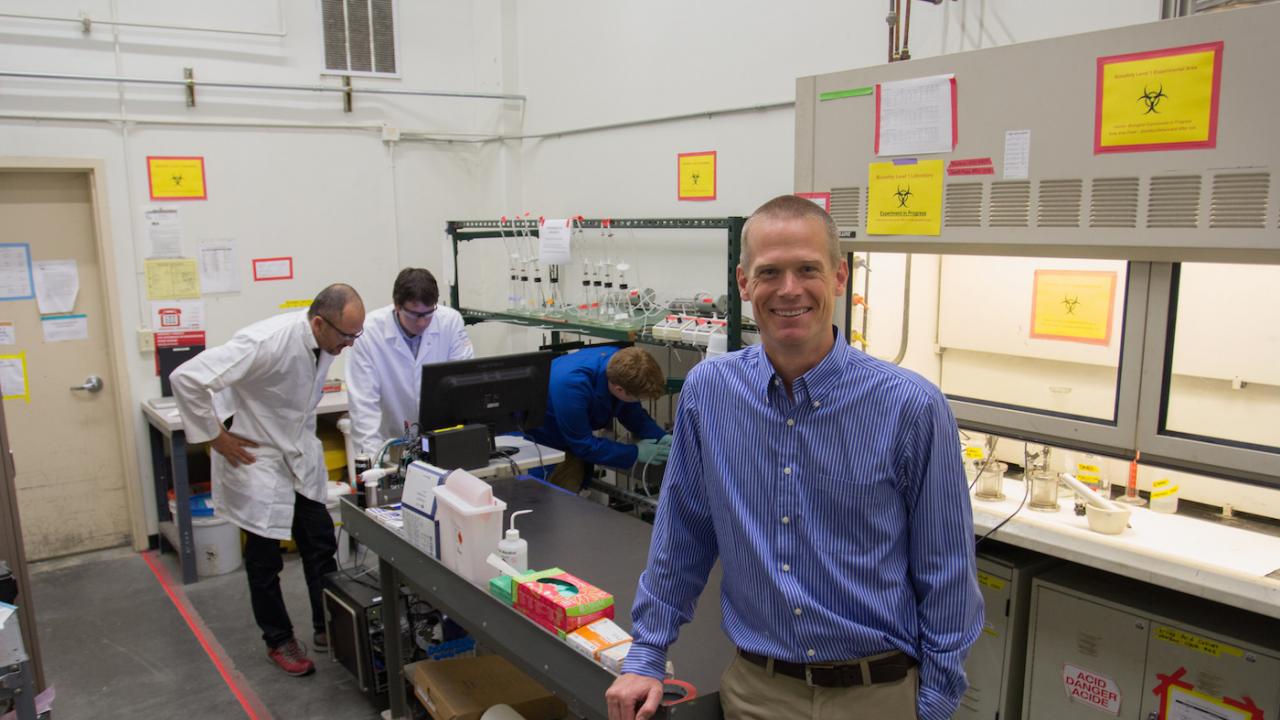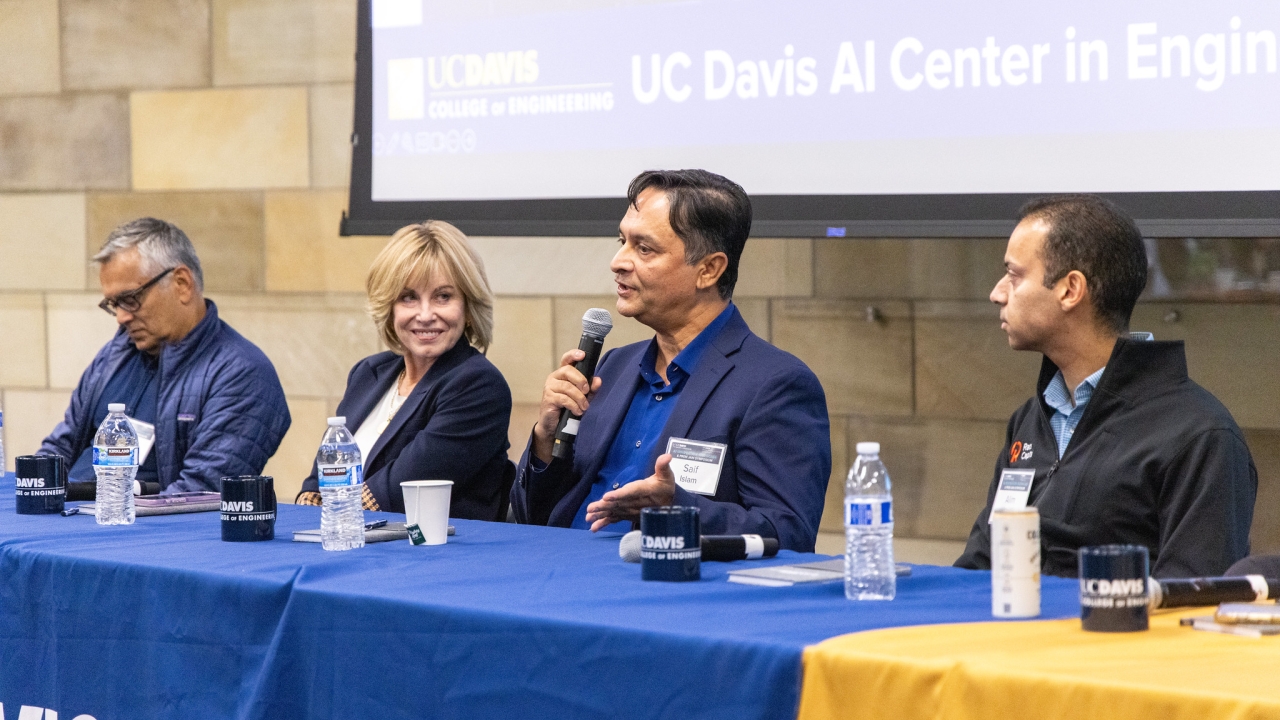
Geotechnical Engineer Jason Dejong Explores “Bio-Soil” Method to Stabilize Future Dams, Bridges And Buildings
By Derrick Bang
JASON DEJONG, a professor in the UC Davis Department of Civil and Environmental Engineering, operates in a field — geotechnical engineering — that is (in)famous for its elusiveness.
“Geotechnical engineers don’t make cars or computers,” he laughs. “We don’t even work with known materials such as steel. I go to a site where a dam must be built, and I examine the material beneath. Do I need to improve it? Replace it? Or can I live with it, and build on top of it? Then what will it do?
“I like the uncertainly and ambiguity of soils and geotechnical engineering. I like the fact that after we do all the calculations, and believe we understand everything, uncertainties still exist. So we have to step back and consider the likelihood of possible outcomes, and balance that against a responsibility to build civil structures that will be safe for society.”
DeJong earned his bachelor of science in civil engineering, with high honors, from UC Davis. He earned both his master’s degree and doctorate at the Georgia Institute of Technology. After research assignments in the oil and gas industries in Western Australia and Norway, he joined UC Davis in 2005.
Since then, DeJong has become a mover and shaker in two distinct areas of his field: dam analysis, to determine structural integrity; and the development of an innovative, biologically enhanced method of improving a construction site’s pre-existing ground conditions. Between the two, he has secured five National Science Foundation grants.
Most recently, he embraced a leadership role in the creation of a new U.S. geotechnical engineering center. UC Davis, Arizona State University, New Mexico State University and the Georgia Institute of Technology have joined forces to create the Center for Bio-inspired and Bio-mediated Geotechnics (CBBG), to expand the rapidly emerging field of biogeotechnical engineering. The National Science Foundation (NSF) will support this new center with a five-year, $18.5 million grant: the nation’s largest single investment in geotechnical research. DeJong will head the UC Davis team.
Back in 2006, his lab published the first peer-reviewed journal article that demonstrated how bio-mediated processes could improve the solidification of loose sands: one of the key geotechnologies within this new ERC. “In many respects,” he notes, “the technical content of the Center proposal built heavily on the work performed by our UC Davis research group.”
The basis for the CBBG also derived heavily from “white papers” that emerged from international workshops co-led in 2007 and 2011 by DeJong and Kenichi Soga, a professor of civil engineering at the UK’s University of Cambridge.
DeJong also remains heavily involved in a massive endeavor to analyze dams throughout the state of California, a project that gained even more urgency following the Richter-6.0 earthquake that struck South Napa in August 2014.
As it happens, many of California’s large dams were built on old river channels composed of gravel and sand, which can liquefy because of earthquake loading; state officials are increasingly concerned that many of these dams may not be safe. DeJong and his team spent much of 2015 observing two dams, in a research project funded by the California Department of Water Resources and the Los Angeles Department of Water and Power.
The two sites are the Stone Canyon Dam, directly above Bel Air, which supplies Los Angeles’ Westside water subsystem; and the Bouquet Canyon Dam, northeast of Santa Clarita, which is the primary fresh water source west of the San Andreas fault, for the northern part of Los Angeles.
“The question, simply, is will the dams hold, or must we do something? And it’s a $50 million to $300 million question!”
Unfortunately, existing equipment couldn’t survive the punishing environment necessary for analysis.
“There wasn’t any known method available to industry, to characterize those gravel-laced soils beneath the dams, because they destroyed equipment and sampling methods. The sensors are at the bottom of a drill hole, being pounded by a pile-driving hammer, through a dam, and then through gravel; we need to take strain and acceleration measurements at 15,000 samples per second, while the computer and everything else are subjected to a thousand G’s of force every 0.6 seconds, with data streaming up to us the entire time.
“We spent 18 months trying to build a piece of equipment that could survive all those conditions, and that was after five earlier years of models that failed. And we finally succeeded.”
The result, dubbed an Instrumented Becker Penetration Test, could become an industry standard.
But analysis is only part of the equation. If a dam is deemed unsafe, can it be made stable by means that are less expensive and cumbersome than starting over, at some geologically superior location?
DeJong began exploring this aspect of his field back in 2003, as a result of his interest in ground improvement: the need to enhance pre-existing soil conditions that are insufficient to provide the desired performance at a construction site.
“Either the soil will settle, or it’ll slip and fail,” he explains. “We go in and improve the ground. Historically, this has been driven by people in industry and construction; they’ll inject grout, cement, silicates, epoxy or something else. Or they’ll vibrate the heck out of it, to densify it. Either way, it’s a high-energy, high-carbon- footprint, brute-force tactic.
“I wondered if there might be a subtler, more optimized alternative. That led to the notion that perhaps we could ‘grow’ a binding calcite — the most stable polymorph of calcium carbonate — by finding the bacteria, the ‘bugs,’ in the ground naturally, or by injecting bacteria and nutrients. If I could do that, I could help prevent buildings from settling, from the weight of a structure; I also could prevent liquefaction.
“So we researched and found the biogeochemical process of calcite precipitation by microbes. I worked with a microbiology colleague at UMass Amherst, and learned how to grow bacteria, get it to multiply, and then harvest it. Then I figured out how to put it in a lab testing device, with soil and loose sand, and learned how to inject the stuff. After getting it to cement up, the result was free- standing, like a brick. It worked!”
Scaling up that lab success to full field deployment, however, would be impractical on many levels. DeJong therefore fine-tuned his approach: With the help of Doug Nelson, a UC Davis professor of microbiology and molecular genetics, the research shifted to the growth and stimulation of native bacteria. The results have been equally promising.
“We can take sand — naturally, from the ground, or from a quarry — and feed it this combination of nutrients, which stimulate the type of existing bacteria that we want to grow. Then we can pump through the calcium, which precipitates and binds the sand particles.”
The result can be called bio-mediated improved soil, or bio-soil, or bio-cement. “The tactical name would be microbial-induced calcite precipitation: MICP. So, we call it MICP-improved sand. Point being, I can give you sandstone in five days.”




